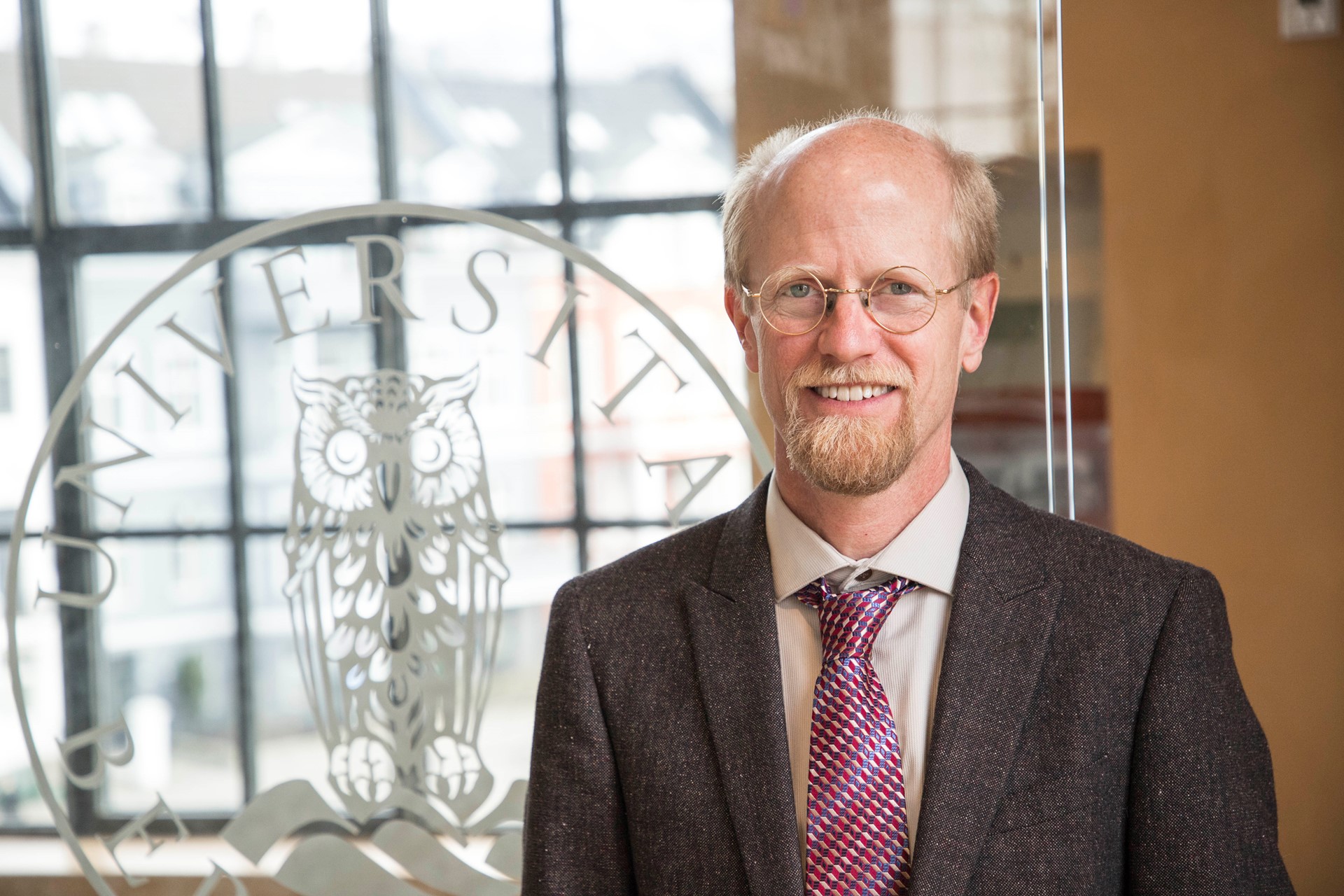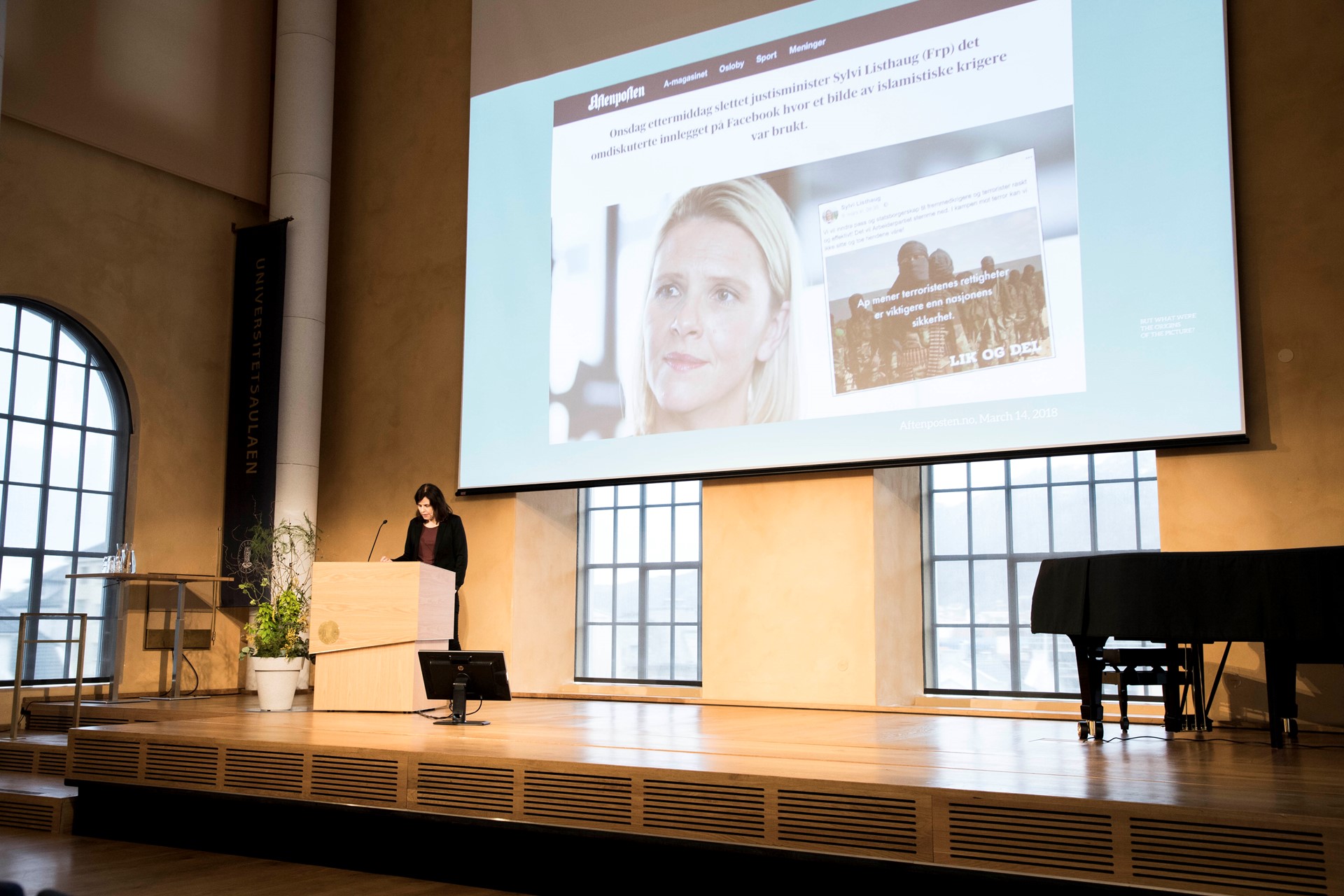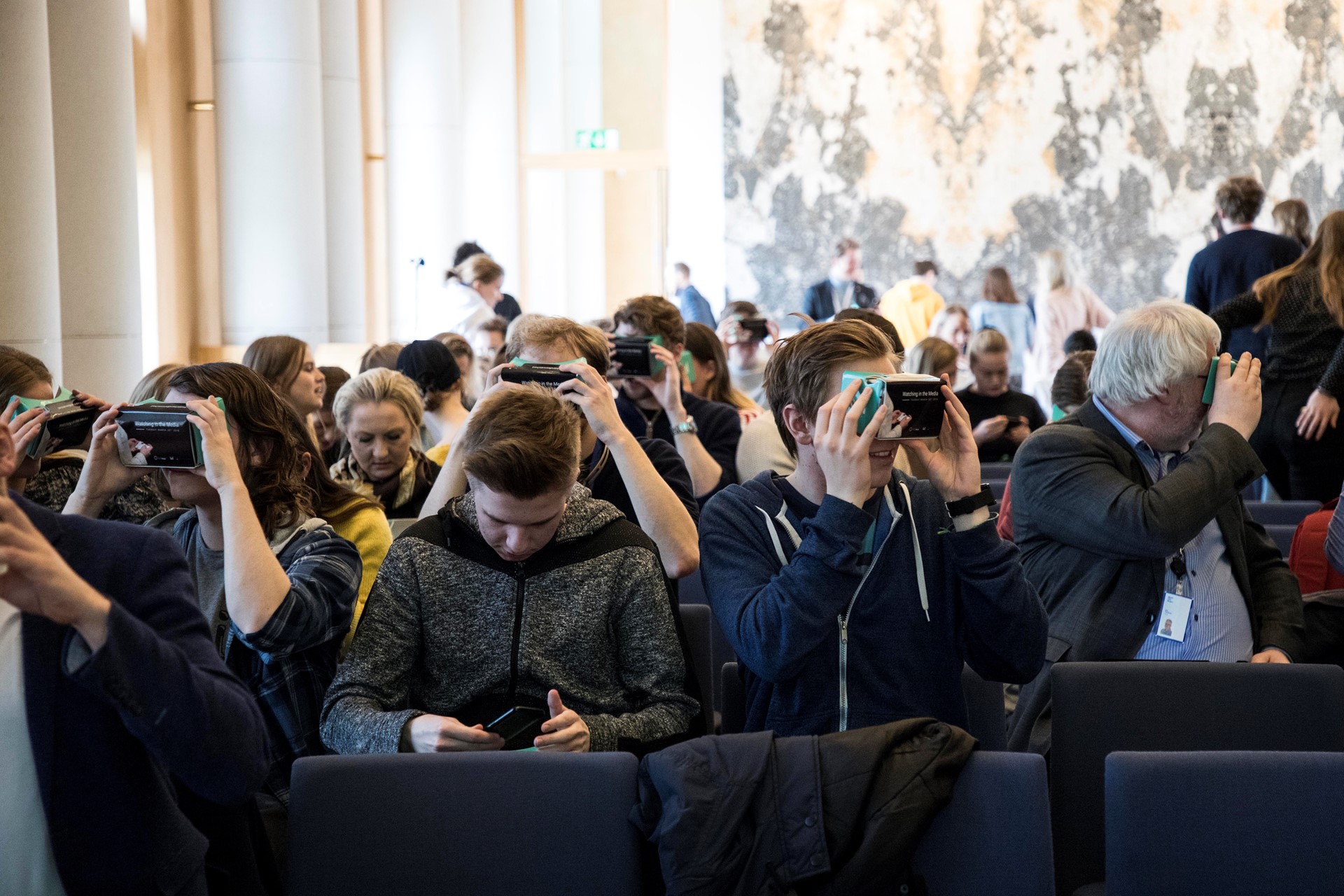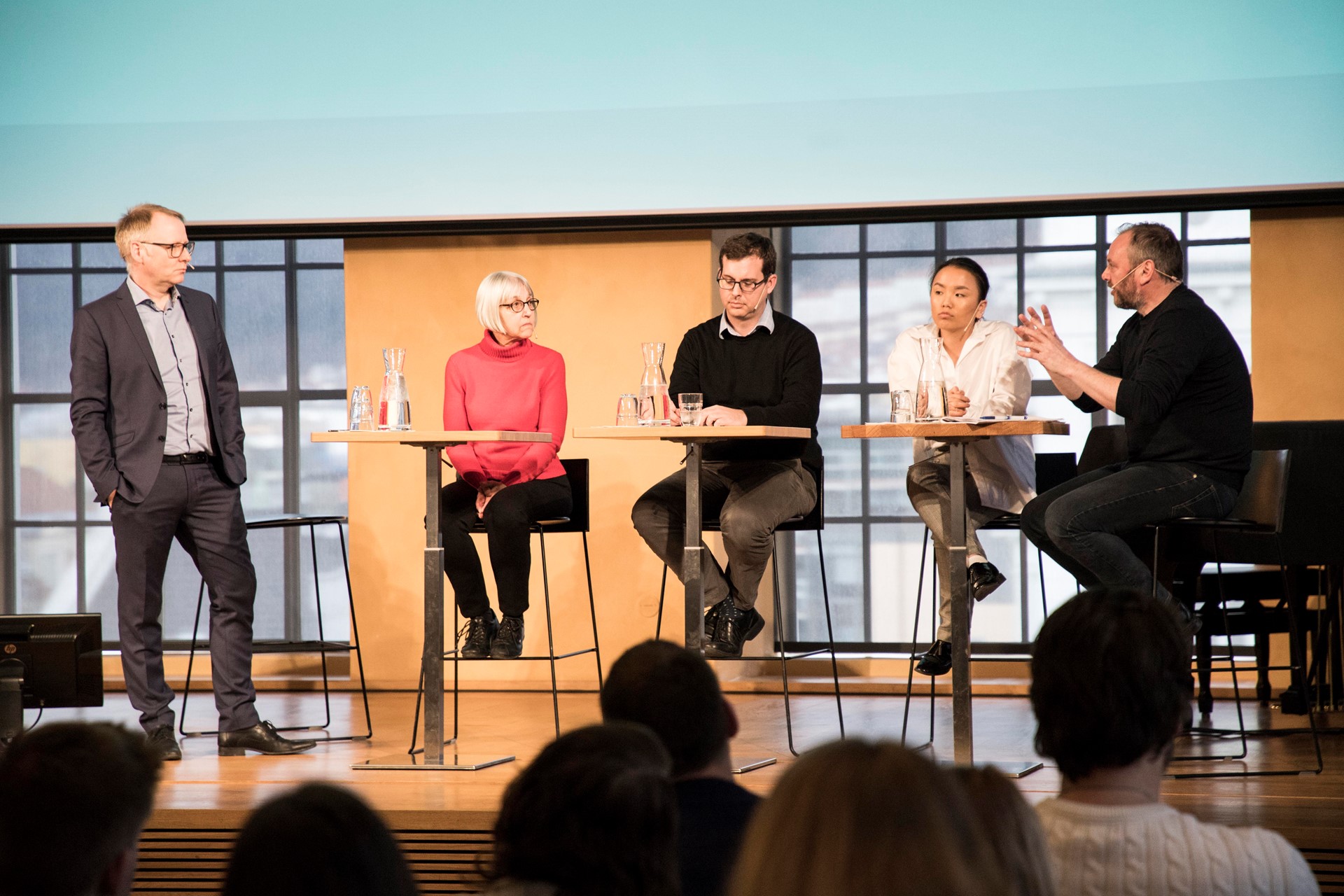Journalism student Maren Myrseth at the University of Bergen (UiB), thought she was being cautious on social media. Until a complete stranger tried to establish contact through facebook, and seemingly knew everything about her life.
– I had never met this man, but he knew where I lived, where I studied, where I used to hang out. Stranger danger is very much real, it just shows up in the digital world these days, Myrseth said.
Myrseth was one of the speakers at Watching in the Media 2018, which was held in the University Aula yesterday. The conference is a free, collaborative event of ViSmedia and NCE Media, for everyone interested in visual technologies, surveillance and news.
Snap Mapping – Network Buildups or Spies in the Skies?
Myrseth gave a talk about her experience with using Snap Map, what it is like to have your every move monitored by your Snapchat friends - and to watch them back.
– It is fun, but it can definitely be misused. We disclose personal information all the time online, without thinking about it. But would you really share that with a stranger on the street, she asked.
 Journalism student at (UiB), Maren Myrseth, giving a talk on Snapchat Snap Map. (Photo: Robert Nedrejord)
Journalism student at (UiB), Maren Myrseth, giving a talk on Snapchat Snap Map. (Photo: Robert Nedrejord)
According to Myrseth, we are being watched through social media all the time.
– Our privacy is just imagined, really. Everyone is doing it. It can't be that bad, we tell ourselves. In reality, we are in a crowded room, with hundreds, or even thousands of people watching.
Clicks That Reveal Who We Are
Journalism is seemingly caught between attention and surveillance, according to Professor Paul C. Adams, from the University of Texas. In his session, «Digital Surveillance in the Attention Economy», he talked about how our online behavior is being converted into revenue-generating data for the media houses.
– With every little click being recorded, the internet knows us better than we know ourselves. Our click-data is extremely valuable to advertisers, he said.
 Professor Paul C. Adams giving a talk on the topic of Digital Surveillance in the Attention Economy (Photo: Robert Nedrejord)
Professor Paul C. Adams giving a talk on the topic of Digital Surveillance in the Attention Economy (Photo: Robert Nedrejord)
Traditional media is taking cues from social media, allowing users to curate their own news.
– What we read and watch, reveals who we are. Major media houses have so much information about our reading-patterns, that they can say something about our personal values, opinions and attitudes. They can also make assumptions about our income, and our levels of influence in the workplace, Adams said.
– This is not only useful when selling products online, it is very efficient in targeting potential voters during an election campaign. A vote is a vote, regardless of the socioeconomic status of the voter. And with this data, campaigns can be tailor-made.
 Professor Paul C. Adams (Photo: Robert Nedrejord)
Professor Paul C. Adams (Photo: Robert Nedrejord)
It is called psychographics, and it is shifting the whole concept of what journalism is all about, according to Adams.
– Journalism used to be the core value driver for news-media outlets. Today, they are selling our attention. This restructuring of media value-drivers is putting our democratic process at risk. I see an unstoppable process that forces journalism into an ethical and moral debate, Adams explained.
The Need for Soul-Searching
Professor Astrid Gynnild, host of the conference and leader of the ViSmedia-project, also thinks it is time for some soul-searching in the news rooms.
– New technologies are definitely here to stay, and more technologies are developed constantly. Our challenge as humans is still to make use of them as tools, and not the new meaning of life, she said.
 Professor at UiB, Astrid Gynnild, with her talk, «Why Watching in the Media» (Photo: Robert Nedrejord)
Professor at UiB, Astrid Gynnild, with her talk, «Why Watching in the Media» (Photo: Robert Nedrejord)
– Personally, I would like to see more news stories on how new technologies impact our daily lives. We need to put our trust in the core values of journalism, she explained.
Gynnild reminded us that it is not the first time we've had to deal with new technology that impacts our lives. She drew parallels to when the car was invented.
– Society suddenly got a new, powerful tool that people had to learn how to handle. Roads became more dangerous, forcing us to introduce speed-limits and rules, Gynnild said.
 Attendees testing out immersive VR goggles at the conference. (Photo: Robert Nedrejord)
Attendees testing out immersive VR goggles at the conference. (Photo: Robert Nedrejord)
 The conference included an interactive panel discussing topics raised during the day. From left: Host Kjetil H. Dale (TV 2), Professor Deborah G. Johnson (University of Virginia), Associate Professor Nicholas Diakopoulos (Northwestern University), Maren Myrseth (UiB), and Professor Lars Nyre (UiB) (Photo: Robert Nedrejord)
The conference included an interactive panel discussing topics raised during the day. From left: Host Kjetil H. Dale (TV 2), Professor Deborah G. Johnson (University of Virginia), Associate Professor Nicholas Diakopoulos (Northwestern University), Maren Myrseth (UiB), and Professor Lars Nyre (UiB) (Photo: Robert Nedrejord)
Opportunities with New Media
An active user of Snapchat, student Maren Myrseth also sees a lot of opportunities with these new media tools, if used responsibly. Like watching the live news-stories in Snap Map, created by Snapchat-users all over the world.

Maren Myrseth with a live demo of Snapchat Snap Map. (Photo: Robert Nedrejord)
– There are a lot of opportunities here, to connect with the world, to facilitate debate, to showcase talent and promote good causes. But we have become so emotionally attached to our online social networks, that we ignore the fact that we are constantly giving away personal info. We believe that we can't live without it, that is why we accept it, she said.
– It is both frightening and satisfying at the same time.
Text by Hilde Gudvangen
About the ViSmedia project:
The ViSmedia project investigates empirically, experimentally, and conceptually how the adoption and adaption of visual surveillance technologies in the news media might best be optimized in ways that integrate the societal responsibility of high quality journalism. The project is interdisciplinary, and the core group of researchers includes social scientists from Norway, USA, and Finland. Read more
